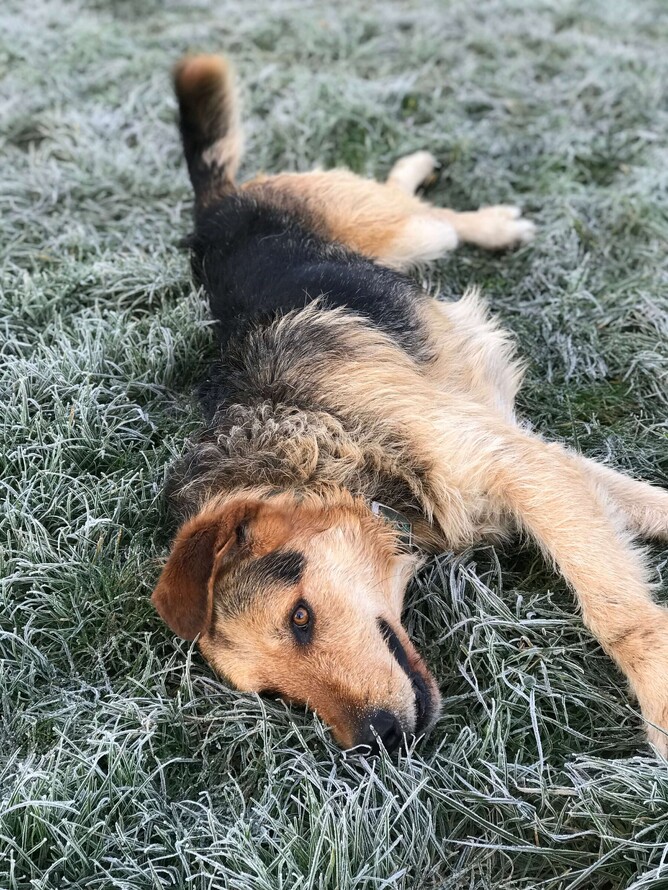With GDV, prompt treatment is crucial to your dog's survival - know what to look out for!
Gastric dilatation volvulus (GDV), commonly called “twisted gut”, is one of the most important reasons that proven, hard working dogs are lost from your farm team.
It has long been reported to be more common in deep chested, large breeds of dogs. It frequently happens in Huntaway dogs, but only occasionally in Heading dogs.
Across all dog breeds, there is a higher incidence of GDV in male dogs than in females. Other predisposing factors leading to the condition include:
Being underweight;
Eating food very quickly (swallowing air);
Being fed one large volume meal a day;
Being stressed from high workload, low quality of nutrition, poor housing, and tense dog team dynamics.
However, in our experience with local farm working dog cases, these patterns are not always seen. In fact, it is often the most experienced and valued dog, in peak condition, that develops this serious problem.
It is thought that some individual working dogs have gastric motility problems. There is also evidence of what appears to be a polygenic predisposition to GDV carried through in some family lines.
Signs to be aware of
Initial signs are often associated with bloating and abdominal pain. These can include, but are not limited to:
An anxious look or looking around at the abdomen;
Standing and stretching, unsettled in kennel at night;
Drooling;
Dry retching, or just some foamy saliva.
As the condition progresses, your dog may begin to pant, have abdominal distension (the bloated stomach may be hidden by the ribcage at first), and be weak or recumbent due to respiratory restriction, abdominal pain and the onset of shock.
What to do if you suspect a GDV
A dog with a GDV is a major medical emergency, but, fortunately, if detected and treated early, survival rates can be good.
Mortality rates associated with gastric dilatation and volvulus have been reported to be approximately 15%.
So, don’t delay your decision! As time passes, some areas of the stomach wall may start to die (gastric necrosis) due to the reduced blood supply to the tissues. The prognosis and survival rate for these cases drops significantly.
Contact your vet clinic to request veterinary assistance and transport your dog there as soon as you can.
Remember that your dog is likely to already be in shock and getting cold. Put a loose fitting dog jacket on him, if available, and transport him under cover to reduce wind chill and further heat loss.
Treatment
Firstly, your dog will be given oxygen, pain relief, shock rate intravenous fluid therapy and have their stomach decompressed to stabilise them.
We will then do some blood tests and radiographs to assess their condition, before sending them off for emergency surgery as soon as possible.
Dogs found collapsed in their kennel may already have significant gastric necrosis by the time they reach the clinic.
Surgery
We carry out a visual inspection of the stomach wall after the gut has been 'untwisted' and blood flow to the stomach has been restored. Some tough decisions may have to be made by you as to the scope of the treatment plan.
One of the surgical steps taken in the treatment of a GDV patient is a technique, called a gastropexy, to create a strong attachment between the stomach wall and the abdominal wall to effectively tether the stomach and reduce the opportunity for it to twist again.
After surgery, your dog will be hospitalised and monitored, given supportive fluid therapy and medications for several days following the procedure.
Post-treatment home care
Initial home care instructions will require you to pay close attention to a strict exercise restriction and a modified feeding plan for several weeks to allow your dog's surgical wounds and stomach wall to heal, and for the gastropexy attachment to become strong.
Long-term care will include dietary management that will likely involve feeding small meals, 2-3 times a day, rather than a single large meal, and continued monitoring for recurrence of clinical signs.
Although it is not ideal to feed dogs close to the time of working, a workable recommendation is to feed a small meal (one cup) of an energy dense diet at least two hours before work and then the balance of the ration within two hours of finishing work.
This would also be recommended for Huntaway dogs that have had problems with bloating or have previously had a twisted stomach (GDV), to reduce the volume of food given per feed.
Preventative surgery
While the gastropexy will not prevent the stomach from expanding, it should serve to prevent the life-threatening gastric volvulus from occurring.
It is possible to perform a 'prophylactic gastropexy' in younger dogs as a preventative measure. This is currently being recommended by many veterinarians for breeds at risk of developing the condition (GDV), or in dogs that are related to others that have had it.

